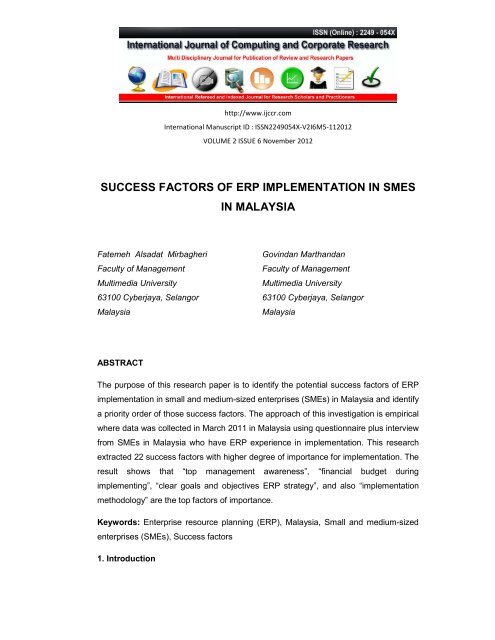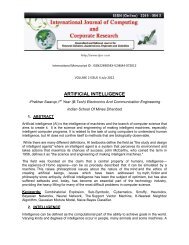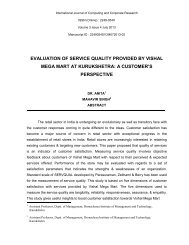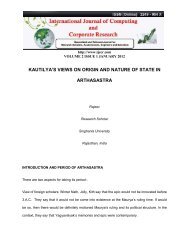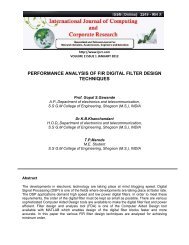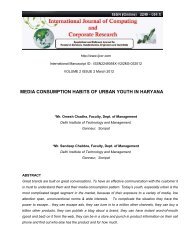success factors of erp implementation in smes in malaysia
success factors of erp implementation in smes in malaysia
success factors of erp implementation in smes in malaysia
Create successful ePaper yourself
Turn your PDF publications into a flip-book with our unique Google optimized e-Paper software.
http://www.ijccr.com<br />
International Manuscript ID : ISSN2249054X-V2I6M5-112012<br />
VOLUME 2 ISSUE 6 November 2012<br />
SUCCESS FACTORS OF ERP IMPLEMENTATION IN SMES<br />
Fatemeh Alsadat Mirbagheri<br />
Faculty <strong>of</strong> Management<br />
Multimedia University<br />
63100 Cyberjaya, Selangor<br />
Malaysia<br />
ABSTRACT<br />
IN MALAYSIA<br />
Gov<strong>in</strong>dan Marthandan<br />
Faculty <strong>of</strong> Management<br />
Multimedia University<br />
63100 Cyberjaya, Selangor<br />
Malaysia<br />
The purpose <strong>of</strong> this research paper is to identify the potential <strong>success</strong> <strong>factors</strong> <strong>of</strong> ERP<br />
<strong>implementation</strong> <strong>in</strong> small and medium-sized ent<strong>erp</strong>rises (SMEs) <strong>in</strong> Malaysia and identify<br />
a priority order <strong>of</strong> those <strong>success</strong> <strong>factors</strong>. The approach <strong>of</strong> this <strong>in</strong>vestigation is empirical<br />
where data was collected <strong>in</strong> March 2011 <strong>in</strong> Malaysia us<strong>in</strong>g questionnaire plus <strong>in</strong>terview<br />
from SMEs <strong>in</strong> Malaysia who have ERP experience <strong>in</strong> <strong>implementation</strong>. This research<br />
extracted 22 <strong>success</strong> <strong>factors</strong> with higher degree <strong>of</strong> importance for <strong>implementation</strong>. The<br />
result shows that “top management awareness”, “f<strong>in</strong>ancial budget dur<strong>in</strong>g<br />
implement<strong>in</strong>g”, “clear goals and objectives ERP strategy”, and also “<strong>implementation</strong><br />
methodology” are the top <strong>factors</strong> <strong>of</strong> importance.<br />
Keywords: Ent<strong>erp</strong>rise resource plann<strong>in</strong>g (ERP), Malaysia, Small and medium-sized<br />
ent<strong>erp</strong>rises (SMEs), Success <strong>factors</strong><br />
1. Introduction
http://www.ijccr.com<br />
International Manuscript ID : ISSN2249054X-V2I6M5-112012<br />
VOLUME 2 ISSUE 6 November 2012<br />
Adoption <strong>of</strong> Information technology (IT) <strong>in</strong> bus<strong>in</strong>ess environment could attract firms to<br />
pursue the <strong>in</strong>stallation <strong>of</strong> system packages to have higher quality coord<strong>in</strong>ation.<br />
Ent<strong>erp</strong>rise Resource Plann<strong>in</strong>g (ERP) system could facilitate a harmony <strong>of</strong> data supply<br />
for <strong>in</strong>ternal and external bus<strong>in</strong>ess process <strong>in</strong> companies. ERP system packages<br />
composed <strong>of</strong> various applications besides tools and techniques which support f<strong>in</strong>ancial<br />
and cost account<strong>in</strong>g, human resource management; computer <strong>in</strong>tegrated<br />
manufactur<strong>in</strong>g, customer <strong>in</strong>formation, sales and distribution, logistic and purchas<strong>in</strong>g,<br />
and project management (Tarn et al., 2002;Beheshti, 2006). S<strong>in</strong>ce data becomes<br />
available, the situation is like customer’s order <strong>in</strong> the bus<strong>in</strong>ess where the system could<br />
work simultaneously. ERP systems have the impact on the value cha<strong>in</strong> that are based<br />
on bus<strong>in</strong>esses where the departments are functional, concentrate on added value<br />
activities and take out errors (Beheshti, 2006). ERP is to have an important place <strong>in</strong><br />
organisations as s<strong>of</strong>tware for <strong>success</strong>ful bus<strong>in</strong>ess (O’Leary, 2000; C<strong>in</strong>dy, 2000).<br />
Plenty <strong>of</strong> firms have implemented ERP as a strong strategy to <strong>in</strong>crease their<br />
competitive advantage. ERP might obta<strong>in</strong> supportive competitive advantages <strong>in</strong> global<br />
level market and also help firms to reduce cost and achieve high quality production<br />
system (Genoulaz & Millet, 2006). Small and midsized ent<strong>erp</strong>rises (SMEs) have the<br />
<strong>in</strong>tention to adopt IT system and also <strong>in</strong>tegrate it with <strong>in</strong>formation system. In order to<br />
adjust systems, SMEs are will<strong>in</strong>g to <strong>in</strong>stall ERP s<strong>of</strong>tware to possess tremendous<br />
coord<strong>in</strong>ation <strong>in</strong> bus<strong>in</strong>ess processes. It is a fact that ERP <strong>in</strong>stallation could have had<br />
higher contribution for be<strong>in</strong>g a <strong>success</strong>ful bus<strong>in</strong>ess. In addition, accord<strong>in</strong>g to economic<br />
growth <strong>of</strong> Malaysia, SMEs are grow<strong>in</strong>g. Therefore, plenty <strong>of</strong> SMEs are <strong>in</strong>terested <strong>in</strong><br />
ERP <strong>in</strong>stallation. This survey explores measurement <strong>of</strong> <strong>success</strong> <strong>factors</strong> <strong>in</strong> SMEs <strong>in</strong><br />
Malaysia, and also to rank those <strong>factors</strong> to present the degree <strong>of</strong> the importance <strong>of</strong><br />
<strong>success</strong> <strong>factors</strong>. The next section reviews literature referr<strong>in</strong>g to the <strong>implementation</strong> <strong>of</strong><br />
ERP by SMEs, ERP <strong>in</strong> Malaysia, SMEs <strong>in</strong> Malaysia, motivation <strong>of</strong> implement<strong>in</strong>g ERP,<br />
and ERP benefits. The “Result” section presents tables <strong>of</strong> measurement <strong>of</strong> <strong>success</strong>
http://www.ijccr.com<br />
International Manuscript ID : ISSN2249054X-V2I6M5-112012<br />
VOLUME 2 ISSUE 6 November 2012<br />
<strong>factors</strong> and their rank<strong>in</strong>gs, and also the paper discloses to contribution <strong>of</strong> researchers,<br />
limitation <strong>of</strong> study and scope <strong>of</strong> future research.<br />
2. Motivation and Research Objectives<br />
In recent years, SMEs are <strong>in</strong>terested <strong>in</strong> ERP <strong>implementation</strong> <strong>in</strong> favour <strong>of</strong> improv<strong>in</strong>g<br />
bus<strong>in</strong>ess processes and also by partner<strong>in</strong>g with large companies like part suppliers <strong>of</strong><br />
manufactur<strong>in</strong>g <strong>in</strong>dustries. Even though ERP <strong>implementation</strong> would require the<br />
bus<strong>in</strong>ess to <strong>in</strong>vest extensively and this effort for adoption <strong>of</strong> system is time consum<strong>in</strong>g<br />
and costly, system <strong>in</strong>stallation has wide range benefits for organizations. Malaysia is a<br />
fast develop<strong>in</strong>g country <strong>in</strong> South East Asia with ascend<strong>in</strong>g economic growth.<br />
Malaysian economy has been transformed from agricultural to <strong>in</strong>dustrial, and also<br />
currently most potent economic sectors are related to <strong>in</strong>formation technology (Bank<br />
Negara Malaysia, 2009). Authors have attempted to get the research on <strong>success</strong><br />
<strong>factors</strong> <strong>of</strong> ERP <strong>implementation</strong> and <strong>in</strong>fluences <strong>in</strong> SMEs specifically <strong>in</strong> Malaysia. The<br />
objectives <strong>of</strong> this research are as below:<br />
• To identify potential <strong>success</strong> <strong>factors</strong> <strong>of</strong> ERP <strong>implementation</strong> <strong>in</strong> Malaysian small<br />
and medium ent<strong>erp</strong>rises.<br />
• To analyze <strong>success</strong> <strong>factors</strong> <strong>of</strong> ERP <strong>implementation</strong> among Malaysian SMEs.<br />
• To rank the <strong>success</strong> <strong>factors</strong> that has impact on ERP <strong>implementation</strong> <strong>in</strong><br />
Malaysia SMEs.<br />
3. Literature Review<br />
3.1 SMEs <strong>in</strong> Malaysia<br />
In this part <strong>of</strong> study we consider the SMEs <strong>in</strong> Malaysia. First <strong>of</strong> all, the classification <strong>of</strong><br />
Malaysian SMEs was categorized <strong>in</strong>to three levels which are (1) Micro-ent<strong>erp</strong>rise, (2)<br />
Small ent<strong>erp</strong>rise and (3) Medium ent<strong>erp</strong>rise. Two key <strong>factors</strong> are used to def<strong>in</strong>e SMEs<br />
which are (1) Annual Sale Turnover and (2) Number <strong>of</strong> Full-Time Employees (THE
http://www.ijccr.com<br />
International Manuscript ID : ISSN2249054X-V2I6M5-112012<br />
VOLUME 2 ISSUE 6 November 2012<br />
IMD, 2009). Manufactur<strong>in</strong>g small and medium ent<strong>erp</strong>rises provide services which are<br />
related to the manufactur<strong>in</strong>g and agro-based <strong>in</strong>dustries with full-time employees that<br />
do not exceed more than 150 OR with annual sales turnover that do not outstrip RM25<br />
million come under SME category (SME Annual Report, 2007). Services, Information &<br />
Communication Technology and Primary Agriculture "Small and medium ent<strong>erp</strong>rises<br />
which are <strong>in</strong> the services, primary agriculture and Information & Communication<br />
Technology (ICT) sectors are ent<strong>erp</strong>rises with full-time employees that do not exceed<br />
more than 50 OR with annual sales turnover not ris<strong>in</strong>g above than RM5 million" (SME<br />
Annual Report, 2007). Full def<strong>in</strong>ition <strong>of</strong> an ent<strong>erp</strong>rise is shown <strong>in</strong> the table below which<br />
is considered as SME <strong>in</strong> Malaysia that was provided by SMIDEC (Small Medium<br />
Industries Development Corporation).<br />
Table1. Def<strong>in</strong>ition <strong>of</strong> SMEs <strong>in</strong> Malaysia<br />
Manufactur<strong>in</strong>g,<br />
Manufactur<strong>in</strong>g-<br />
Related Services<br />
and Agro-based<br />
<strong>in</strong>dustries<br />
Services, Primary<br />
Agriculture and<br />
Information &<br />
Communication<br />
Micro-ent<strong>erp</strong>rise<br />
Sales turnover <strong>of</strong><br />
less than<br />
RM250,000 OR full<br />
time employees<br />
less than 5<br />
Sales turnover <strong>of</strong><br />
less than<br />
RM200,000 OR full<br />
time employees<br />
Small ent<strong>erp</strong>rise<br />
Sales turnover<br />
between<br />
RM250,000 and<br />
less than RM10<br />
million OR full time<br />
employees<br />
between 5 and 50<br />
Sales turnover<br />
between<br />
RM200,000 and<br />
less than RM1<br />
Medium<br />
ent<strong>erp</strong>rise<br />
Sales turnover<br />
between RM10<br />
million and RM25<br />
million OR full time<br />
employees<br />
between 51 and<br />
150<br />
Sales turnover<br />
between RM1<br />
million and RM5<br />
million OR full time
http://www.ijccr.com<br />
International Manuscript ID : ISSN2249054X-V2I6M5-112012<br />
VOLUME 2 ISSUE 6 November 2012<br />
Technology (ICT) less than 5 million OR full time<br />
employees<br />
between 5 and 19<br />
employees<br />
between 20 and 50<br />
Source: SMECorp (SMALLMEDIUM ENTERPRISES CORPORATION MALAYSIA)<br />
SMEs are function<strong>in</strong>g <strong>in</strong> nearly all types <strong>of</strong> <strong>in</strong>dustries, and besides they are different <strong>in</strong><br />
their range and importance (Idrus & Shahawai, 2009). A study which was done by<br />
Bank Negara Malaysia has reported the present number <strong>of</strong> SMEs <strong>in</strong> Malaysia is<br />
349,617(Bank Negara Malaysia, 2009). The percentage <strong>of</strong> SMEs <strong>in</strong> Malaysia reports<br />
for 99.2 % from the total establishments which numbers 518,996 <strong>in</strong> the three ma<strong>in</strong><br />
economic sectors: manufactur<strong>in</strong>g, services and agriculture <strong>in</strong> 2006 (Aris, 2007). With<br />
this statistic <strong>in</strong>formation, it proves that SMEs play an important role as one <strong>of</strong> the<br />
contributors <strong>in</strong> economy <strong>of</strong> Malaysia and are pr<strong>of</strong>itable <strong>in</strong> this matter (Idrus &<br />
Shahawai, 2009). In some <strong>of</strong> the Asian countries such as Ch<strong>in</strong>a, Japan and Korea, the<br />
economic growth has been <strong>in</strong>fluenced by activities <strong>of</strong> SMEs where their Gross<br />
Domestic Product (GDP) had achieved more than 50% <strong>in</strong> comparison to Malaysia<br />
(SME Annual Report, 2007). That shows the percentage <strong>in</strong> Malaysia might be lower<br />
than other countries <strong>in</strong> Asia, but the government had found out that the SMEs future<br />
potential are greatly improv<strong>in</strong>g where there is expectation to impact heavily on the<br />
economy. It is <strong>in</strong>deed a motivation for better effectiveness <strong>in</strong> higher ICT usage plus<br />
bus<strong>in</strong>ess process. The government are encourag<strong>in</strong>g SMEs by provid<strong>in</strong>g the best<br />
opportunity to uptake the best bus<strong>in</strong>ess practices adoption to be competitive <strong>in</strong> the<br />
global and local market (SME Annual Report, 2007). Value added production from<br />
SMEs is anticipated to be valued at RM120 billion or 50 per cent <strong>of</strong> total production <strong>in</strong><br />
the manufactur<strong>in</strong>g sector by 2020 (Saleh & Ndubisi, 2006).<br />
3.2 ERP <strong>in</strong> Malaysia
http://www.ijccr.com<br />
International Manuscript ID : ISSN2249054X-V2I6M5-112012<br />
VOLUME 2 ISSUE 6 November 2012<br />
In recent years <strong>in</strong> Malaysia, ICT growth is achiev<strong>in</strong>g higher order. Accord<strong>in</strong>g to<br />
economic growth and improv<strong>in</strong>g IT <strong>in</strong>frastructure, SMEs are upgrad<strong>in</strong>g their<br />
ent<strong>erp</strong>rises and adopt<strong>in</strong>g Information Technology. In addition, <strong>in</strong> Asia-Pacific region,<br />
ERP s<strong>of</strong>tware vendors are experienc<strong>in</strong>g global expansion by concentrat<strong>in</strong>g and<br />
target<strong>in</strong>g on SMEs <strong>in</strong> develop<strong>in</strong>g countries (Huang & Palvia, 2001). Malaysia could<br />
make achiev<strong>in</strong>g progress <strong>in</strong> its economy to a great extent <strong>in</strong> South East Asia. Their<br />
<strong>in</strong>vestment predom<strong>in</strong>ately expanded on the technique which was used dur<strong>in</strong>g the 1997<br />
economic crisis, the “corporate-wide <strong>in</strong>tegration, corporate restructur<strong>in</strong>g and<br />
technological <strong>in</strong>novation policies” that was encouraged by the Malaysian government<br />
all over public and private sectors (M<strong>in</strong>istry <strong>of</strong> F<strong>in</strong>ance, 2009). Organizational and<br />
technological <strong>in</strong>novations <strong>of</strong> mult<strong>in</strong>ational companies play the two ma<strong>in</strong> roles <strong>in</strong><br />
Malaysian import and export <strong>success</strong> and economic growth. They could make plenty<br />
<strong>of</strong> growth shares (Hobday, 1996).<br />
The future growth trends <strong>of</strong> s<strong>of</strong>tware market <strong>of</strong> Malaysian mid market ERP was<br />
<strong>in</strong>vestigated by Frost & Sullivan <strong>in</strong> 2004. The number <strong>of</strong> SMEs which are look<strong>in</strong>g to<br />
adopt IT system is more than 10,000 <strong>in</strong> Malaysia. The SMEs have attempt<strong>in</strong>g to<br />
compete <strong>in</strong> customer service globally .The ERP vendors <strong>of</strong>fer ERP systems <strong>in</strong> lower<br />
cost and customizable to mid market. SMEs are encouraged to adopt this system <strong>in</strong><br />
order to strategic <strong>in</strong>vestment view po<strong>in</strong>t <strong>in</strong> the wake <strong>of</strong> <strong>in</strong>creas<strong>in</strong>g return <strong>of</strong> <strong>in</strong>vestment.<br />
Majority <strong>of</strong> SMEs who are adapted to ERP <strong>in</strong> Malaysia are experienced <strong>success</strong>fully<br />
by customization from local or <strong>in</strong>ternational vendors. Various sectors such as<br />
manufactur<strong>in</strong>g, utilities, technology, high tech, and also government <strong>in</strong> SMEs are<br />
<strong>success</strong>ful to implement ERP systems <strong>in</strong> Malaysia (Frost & Sullivan, 2004).<br />
3.3 Implementation <strong>of</strong> ERP at Malaysian SMEs<br />
Competitive environment and globalization caused the <strong>implementation</strong> <strong>of</strong> ERP by<br />
SMEs and adoption <strong>of</strong> a wide range <strong>of</strong> <strong>in</strong>formation technology to rival under new
http://www.ijccr.com<br />
International Manuscript ID : ISSN2249054X-V2I6M5-112012<br />
VOLUME 2 ISSUE 6 November 2012<br />
conditions (Maldonado, 2009). Although ERP systems are implemented <strong>in</strong> large<br />
ent<strong>erp</strong>rise, SMEs are motivated to run ERP on ent<strong>erp</strong>rise (Adam & O’doherty, 2000).<br />
Indeed, ERP <strong>implementation</strong> <strong>in</strong> SMEs is not so different from large ent<strong>erp</strong>rise. SMEs<br />
try to implement ERP to raise performance <strong>of</strong> departments through ent<strong>erp</strong>rise by<br />
provid<strong>in</strong>g real-time <strong>in</strong>formation, hav<strong>in</strong>g best practices dur<strong>in</strong>g bus<strong>in</strong>ess processes, and<br />
updat<strong>in</strong>g obsolete technical platforms (Adam & O’doherty, 2000). Utterly, the largest<br />
ERP application users are <strong>in</strong>cluded such as manufactur<strong>in</strong>g, utilities, technology, high<br />
tech, and also government through Malaysian SMEs. As an <strong>in</strong>stance, manufactur<strong>in</strong>g<br />
has experienced high growth with contribution more than 70 percent <strong>of</strong> revenue and 55<br />
percent <strong>of</strong> the employment <strong>in</strong> 2003(Frost & Sullivan, 2004). Therefore, SMEs are<br />
encouraged to implement ERP to ga<strong>in</strong> more beneficial outcomes and <strong>in</strong>creas<strong>in</strong>g<br />
revenues with<strong>in</strong> the competitive market.<br />
3.4 Motivation <strong>of</strong> Implement<strong>in</strong>g ERP<br />
Companies have had different experiences <strong>of</strong> ERP <strong>implementation</strong> based on the<br />
<strong>in</strong>tention to ERP <strong>in</strong>stallations. The <strong>implementation</strong>s which produce technically-led<br />
consequences <strong>in</strong> a higher degree designed system that supports approximately and<br />
perfectly fit with the processes <strong>of</strong> the organization that it does not get an eye catch<strong>in</strong>g<br />
outcome <strong>in</strong> the short term period <strong>of</strong> runn<strong>in</strong>g. In place <strong>of</strong> the <strong>implementation</strong>s are<br />
bus<strong>in</strong>ess-led concentrated and conduct to get a higher level performance <strong>of</strong> f<strong>in</strong>ance <strong>in</strong><br />
a short term period (Velco, 2007). In fact, ERP <strong>implementation</strong> would concentrate<br />
f<strong>in</strong>ancial cost <strong>of</strong> firms by upgrad<strong>in</strong>g bus<strong>in</strong>ess process and solve concerns <strong>of</strong> bus<strong>in</strong>ess-<br />
related data flow. Companies tend to engage <strong>implementation</strong> this system.<br />
3.5 Benefits <strong>of</strong> ERP System<br />
There are a varied reasons for ERP <strong>implementation</strong> such as provid<strong>in</strong>g s<strong>in</strong>gle data<br />
source, reduce cost, <strong>in</strong>tegrate bus<strong>in</strong>ess processes while reduc<strong>in</strong>g <strong>in</strong>direct costs, high<br />
speed customer reactivity and the <strong>in</strong>creas<strong>in</strong>g productivity <strong>of</strong> <strong>of</strong>fice. Plus,
http://www.ijccr.com<br />
International Manuscript ID : ISSN2249054X-V2I6M5-112012<br />
VOLUME 2 ISSUE 6 November 2012<br />
<strong>in</strong>tergradations <strong>of</strong> bus<strong>in</strong>ess processes are very crucial benefits <strong>of</strong> <strong>in</strong>stall<strong>in</strong>g ERP which<br />
is also one <strong>of</strong> the primary objectives (Davenport, 2000). Other benefits <strong>of</strong> ERP<br />
adoption <strong>in</strong>clude support <strong>in</strong> reduc<strong>in</strong>g <strong>in</strong>ventory costs, <strong>in</strong>creas<strong>in</strong>g efficiency, improv<strong>in</strong>g<br />
pr<strong>of</strong>itability and reduc<strong>in</strong>g lead time <strong>of</strong> manufactur<strong>in</strong>g <strong>in</strong> bus<strong>in</strong>ess processes. An ERP<br />
system can pass through an organization by drastically affect<strong>in</strong>g several processes,<br />
and also show<strong>in</strong>g at various levels <strong>of</strong> benefits (Zhu et al., 2010). ERP system would<br />
have provided high effective situation for company environment to reach higher<br />
potential dur<strong>in</strong>g monitor<strong>in</strong>g changes <strong>of</strong> environment for future, which can also affect<br />
the position <strong>of</strong> the bus<strong>in</strong>ess constantly (Huang & Palvia, 2001).<br />
4. Methodology<br />
The sampl<strong>in</strong>g method <strong>of</strong> this study is non probability for the sake <strong>of</strong> a small targeted<br />
population, so no random sampl<strong>in</strong>g was done. Accord<strong>in</strong>g to population, 250<br />
companies seemed to be capable to respond to the questionnaire and provide an<br />
<strong>in</strong>terview with their managers and ERP experts. The study ended up, however, with<br />
107 responded samples out <strong>of</strong> the 250 (42.8% response rate). The analysis <strong>of</strong> data<br />
shows that 51% <strong>of</strong> respondents have work<strong>in</strong>g experience more than 20 years, 34%<br />
between 10 to 20 years, and also 15% less than 10 years. In addition, 43 % <strong>of</strong><br />
respondents have IT background.<br />
This study was restricted to all small and medium-sized companies <strong>in</strong> Malaysia which<br />
either implemented some forms <strong>of</strong> ERP or total ERP <strong>implementation</strong>. The components<br />
<strong>in</strong>clud<strong>in</strong>g such as f<strong>in</strong>ancial management and account<strong>in</strong>g, production plann<strong>in</strong>g, sales<br />
and distribution or logistics, asset management, customer relationship management,<br />
material and <strong>in</strong>ventory management, quality management, human resource and<br />
payroll are <strong>in</strong>stalled more <strong>in</strong> SMEs. Manufactur<strong>in</strong>g, eng<strong>in</strong>eer<strong>in</strong>g and construction,<br />
computer service and high tech, bank, utilities sectors are largest segment to<br />
implement ERP system though. In this survey, the population consists <strong>of</strong> ERP experts
http://www.ijccr.com<br />
International Manuscript ID : ISSN2249054X-V2I6M5-112012<br />
VOLUME 2 ISSUE 6 November 2012<br />
and managers <strong>of</strong> SMEs <strong>in</strong> any <strong>in</strong>dustries <strong>in</strong> Malaysia. In order to the contact those<br />
ent<strong>erp</strong>rises, the researcher have sent emails to many companies to make a list <strong>of</strong><br />
those small and medium companies that have implemented either ERP or even some<br />
forms <strong>of</strong> ERP. Plus, some small and medium-sized companies <strong>in</strong> Malaysia are<br />
plann<strong>in</strong>g to run ERP. For collection <strong>of</strong> data, the researcher went to companies for a<br />
structured <strong>in</strong>terview or questionnaire survey forms were sent by email to managers or<br />
ERP experts who are work<strong>in</strong>g or collaborat<strong>in</strong>g with the ent<strong>erp</strong>rises. Questionnaire<br />
send<strong>in</strong>g was sometimes one to many, because <strong>in</strong> few companies more than one<br />
person is responsible for ERP <strong>implementation</strong>, and they could respond to<br />
questionnaire. The survey is one-time cross-sectional and the unit <strong>of</strong> analysis <strong>of</strong> this<br />
study is the ent<strong>erp</strong>rise.<br />
5. Instrument Development<br />
In this study, the questionnaire was used to collect data. First part <strong>of</strong> the questionnaire<br />
was derived from questionnaire <strong>of</strong> PhD student thesis from Multimedia University <strong>in</strong><br />
field <strong>of</strong> ERP <strong>implementation</strong>, and second part is exc<strong>erp</strong>ted from the <strong>in</strong>vestigation <strong>of</strong><br />
ERP <strong>in</strong> SMEs <strong>in</strong> India and modified to this form for Malaysia SMEs and measurement<br />
is based on five Likert scale form strongly disagree to strongly agree (1 = Strongly<br />
Disagree, 2 = Disagree, 3 = Neutral, 4 = Agree, 5 = Strongly Agree). The questionnaire<br />
was validated by review<strong>in</strong>g with ERP specialists and academic sett<strong>in</strong>g as well. All<br />
experts <strong>in</strong> this study agreed on the appropriateness, clarity <strong>of</strong> the items and contents <strong>in</strong><br />
this questionnaire. This study showed that there were clear and comprehensive ways<br />
to respond to the questionnaire and all respondents had agreed that the questionnaire<br />
<strong>of</strong> the study has clarity and adequate content <strong>of</strong> the items. In addition, the reliability <strong>of</strong><br />
questionnaire was 0.87 based on Cornbach’s Alpha formula.<br />
6. Analysis and Results
http://www.ijccr.com<br />
International Manuscript ID : ISSN2249054X-V2I6M5-112012<br />
VOLUME 2 ISSUE 6 November 2012<br />
Data analysis was from qualitative to quantitative. To measure <strong>success</strong> <strong>factors</strong><br />
statistical tools are required. The Statistical Package for the Social Sciences Version<br />
17.0 (SPSS) was utilized to analyze those data. The test <strong>of</strong> analyz<strong>in</strong>g these questions<br />
is student’s t-test. The <strong>success</strong> <strong>factors</strong> were tested by T-test and gett<strong>in</strong>g mean values<br />
<strong>of</strong> them. In the overall analysis, compar<strong>in</strong>g mean values and then choos<strong>in</strong>g higher<br />
degree <strong>factors</strong> as important <strong>factors</strong> <strong>of</strong> ERP <strong>implementation</strong> <strong>in</strong> Malaysian SMEs is<br />
done.<br />
The <strong>success</strong> <strong>factors</strong> are categorized <strong>in</strong>to 21 different categories as mentioned <strong>in</strong><br />
Table 2. There are two to n<strong>in</strong>e <strong>factors</strong> <strong>in</strong> each category. As shown <strong>in</strong> Table 2, each<br />
category used an acronym to <strong>in</strong>dicate each one <strong>in</strong> the follow<strong>in</strong>g text. In Table 2,<br />
rank<strong>in</strong>g <strong>of</strong> 21 categories by their mean were shown. It is noticed that Top management<br />
<strong>in</strong>volvement and commitment, Monitor<strong>in</strong>g and evaluation <strong>of</strong> performance, Project<br />
management and evaluation have three higher degree <strong>of</strong> rank <strong>in</strong> compar<strong>in</strong>g with other<br />
<strong>success</strong> categories with<strong>in</strong> SMEs <strong>in</strong> Malaysia respectively. Although <strong>success</strong> <strong>factors</strong><br />
were measured <strong>in</strong> various studies <strong>in</strong> develop<strong>in</strong>g countries, <strong>in</strong> this <strong>in</strong>vestigation all<br />
<strong>factors</strong> categorized <strong>in</strong> 21 categories. In order to categoriz<strong>in</strong>g <strong>success</strong> <strong>factors</strong>, readers<br />
might understand <strong>in</strong> organized modification with priority degree. In all categories found<br />
whole possible reasons which are important <strong>in</strong> SMEs and modified for develop<strong>in</strong>g<br />
countries.<br />
Table 2. Rank<strong>in</strong>g <strong>of</strong> Success Factor Categories <strong>in</strong> ERP Implementation <strong>in</strong><br />
Malaysian SMEs<br />
Rank Categories <strong>of</strong> Success Factors Symbol Mean<br />
1 Top management <strong>in</strong>volvement and commitment TMIC 4.0536<br />
2 Monitor<strong>in</strong>g and evaluation <strong>of</strong> performance MEP 3.89<br />
3 Project management and evaluation PME 3.13<br />
4 Bus<strong>in</strong>ess plan and long-run vision BPLV 2.99
http://www.ijccr.com<br />
International Manuscript ID : ISSN2249054X-V2I6M5-112012<br />
VOLUME 2 ISSUE 6 November 2012<br />
5 Bus<strong>in</strong>ess and IT legacy systems BITLS 2.95<br />
6 Use <strong>of</strong> consultant UC 2.86<br />
7 S<strong>of</strong>tware analysis, test<strong>in</strong>g and troubleshoot<strong>in</strong>g SATT 2.73<br />
8 Ent<strong>erp</strong>rise Information management EIM 2.61<br />
9 User <strong>in</strong>volvement UI 2.58<br />
10 User tra<strong>in</strong><strong>in</strong>g and education UTE 2.56<br />
11 Knowledge management KM 2.53<br />
12 Selection <strong>of</strong> ERP S<strong>of</strong>tware SERPS 2.51<br />
13 Vendor support VS 2.49<br />
14 System quality SQ 2.47<br />
15 Change management program CMP 2.43<br />
16 Corporate culture CC 2.41<br />
17 ERP team composition, competence and compensation ERPTCCC 2.40<br />
18 Bus<strong>in</strong>ess process reeng<strong>in</strong>eer<strong>in</strong>g and m<strong>in</strong>imum<br />
customization<br />
BPRMC 2.37<br />
19 Project champion PC 2.31<br />
20 Ent<strong>erp</strong>rise-wide communication and cooperation ECC 2.23<br />
21 Risk management RM 2.13<br />
The first 22 effective variables <strong>in</strong> the <strong>success</strong> <strong>of</strong> ERP <strong>implementation</strong> <strong>in</strong> SMEs <strong>in</strong><br />
Malaysia is <strong>in</strong> the order shown <strong>in</strong> Table 3. In this table, all those <strong>factors</strong> which have<br />
high degree <strong>of</strong> importance <strong>in</strong> ERP <strong>implementation</strong> <strong>in</strong> Malaysian SMEs are mentioned.<br />
Table 3. Success Factors by High Degree <strong>of</strong> Importance <strong>in</strong> ERP Implementation<br />
Rank Category Top Success Factor Mean<br />
1 TMIC Top management awareness 4.21
http://www.ijccr.com<br />
International Manuscript ID : ISSN2249054X-V2I6M5-112012<br />
VOLUME 2 ISSUE 6 November 2012<br />
2 PME F<strong>in</strong>ancial budget dur<strong>in</strong>g implement<strong>in</strong>g 4.16<br />
3 BPLV Clear goals and objectives 4.07<br />
4 BPLV ERP strategy and <strong>implementation</strong> methodology 4.03<br />
5 TMIC Top management support 3.97<br />
6 UC Consultant support 3.92<br />
7 PME Project schedule and plan 3.90<br />
8 MEP Monitor<strong>in</strong>g and feedback <strong>implementation</strong> 3.89<br />
9 BPLV Look<strong>in</strong>g ERP as a strategic <strong>in</strong>vestment 3.87<br />
10 CMP Organizational resistance to change 3.84<br />
11 PME Proper report<strong>in</strong>g structure 3.80<br />
12 BITLS Appropriate bus<strong>in</strong>ess and IT legacy systems 3.78<br />
13 EIM Strong MIS department 3.69<br />
14 SATT Adequate test<strong>in</strong>g 3.63<br />
15 CC Cultural fit 3.59<br />
16 UI Will<strong>in</strong>gness to participate 3.57<br />
17 ERPTCCC Project team competence 3.49<br />
18 SATT Data accuracy 3.44<br />
19 SERPS Related experience <strong>of</strong> supplier 3.36<br />
20 BPRMC Bus<strong>in</strong>ess process improvement, optimization, and<br />
reeng<strong>in</strong>eer<strong>in</strong>g<br />
21 BITLS Integration and communication between legacy<br />
system and ERP<br />
3.29<br />
3.17<br />
22 SQ System stability 3.08<br />
By consider<strong>in</strong>g users’ views, those <strong>factors</strong> which were mentioned <strong>in</strong> table 3 are crucial<br />
and effective for hav<strong>in</strong>g <strong>success</strong>ful <strong>implementation</strong>. The survey showed top<br />
management awareness <strong>in</strong> top management <strong>in</strong>volvement and commitment category,
http://www.ijccr.com<br />
International Manuscript ID : ISSN2249054X-V2I6M5-112012<br />
VOLUME 2 ISSUE 6 November 2012<br />
F<strong>in</strong>ancial budget dur<strong>in</strong>g implement<strong>in</strong>g <strong>in</strong> project management and evaluation category,<br />
Clear goals and objectives, ERP strategy and <strong>implementation</strong> methodology <strong>in</strong><br />
bus<strong>in</strong>ess plan and long-run vision category respectively. The results is compar<strong>in</strong>g with<br />
other develop<strong>in</strong>g countries <strong>in</strong> Asia such as India, South Korea, S<strong>in</strong>gapore. Accord<strong>in</strong>g<br />
to results, the <strong>success</strong> <strong>factors</strong> are close together however the priority is different. In<br />
fact, those <strong>factors</strong> which are related to top management, f<strong>in</strong>ancial budget, strategy and<br />
goals, consultants are seen as crucial <strong>factors</strong> to reach <strong>success</strong> <strong>implementation</strong><br />
particularly <strong>in</strong> SMEs through develop<strong>in</strong>g countries specially <strong>in</strong> Asia.<br />
7. Contribution<br />
Adoption <strong>of</strong> Information technology on SMEs <strong>in</strong> Malaysia is grow<strong>in</strong>g <strong>in</strong> relation to<br />
literature review. Observation, <strong>in</strong>terviews and questionnaire could demonstrate many<br />
variables which are important <strong>in</strong> higher degree and effectiveness for implement<strong>in</strong>g<br />
ERP with<strong>in</strong> Malaysia. The experience <strong>of</strong> some SMEs which attended to this study<br />
show top management <strong>in</strong>volvement and commitment category <strong>of</strong> <strong>success</strong> <strong>factors</strong> has<br />
more priority. In this category top management awareness and support are two<br />
important variables which cover this category. In addition, Top management can<br />
provide smoother environment with support and commitment. Awareness <strong>of</strong> top<br />
management while implement<strong>in</strong>g ERP <strong>in</strong> SMEs br<strong>in</strong>gs better results to obta<strong>in</strong><br />
cooperation <strong>of</strong> company staffs and coord<strong>in</strong>ation <strong>in</strong> right path. The survey supports<br />
project management and provides evaluation <strong>of</strong> category <strong>of</strong> <strong>success</strong> factor that play a<br />
vital role to conduct <strong>success</strong>ful <strong>implementation</strong>. In this study, we would concentrate on<br />
the f<strong>in</strong>ancial budget dur<strong>in</strong>g <strong>implementation</strong>, project schedule and plann<strong>in</strong>g, and also<br />
proper report<strong>in</strong>g structure. In fact, evaluation <strong>of</strong> project manager for possess<strong>in</strong>g a<br />
realistic and feasible schedule and constructive plann<strong>in</strong>g can facilitate to assess<br />
f<strong>in</strong>ancial budget before, dur<strong>in</strong>g and after <strong>implementation</strong>. F<strong>in</strong>ancial budget dur<strong>in</strong>g<br />
<strong>implementation</strong> is more effective and beneficial to have <strong>success</strong>ful ERP
http://www.ijccr.com<br />
International Manuscript ID : ISSN2249054X-V2I6M5-112012<br />
VOLUME 2 ISSUE 6 November 2012<br />
<strong>implementation</strong> <strong>in</strong> SMEs. In this way, report<strong>in</strong>g is able to manifest the outcomes <strong>of</strong><br />
team members’ efforts.<br />
As a closer view, bus<strong>in</strong>ess plan and long-run vision is another aspect <strong>in</strong> <strong>success</strong>ful<br />
ERP <strong>implementation</strong>. This category is strategically varied. Variables such as clear<br />
goals and objectives, ERP strategy and <strong>implementation</strong> methodology, and look<strong>in</strong>g at<br />
ERP as a strategic <strong>in</strong>vestment have more portion <strong>in</strong> regards <strong>of</strong> <strong>success</strong>ful<br />
<strong>implementation</strong>. The efficient strategy, clear goals, mission and vision <strong>of</strong><br />
<strong>implementation</strong> <strong>in</strong> IT projects <strong>in</strong> SMEs can reduce the cost <strong>of</strong> <strong>implementation</strong>. Some<br />
consultants aid top managers to select methodology <strong>in</strong> provid<strong>in</strong>g company’s goals.<br />
Therefore, managers should see ERP <strong>implementation</strong> and IT adaption as a strategic<br />
<strong>in</strong>vestment as well. Plus, many small corporations which are not regard<strong>in</strong>g these<br />
variables might fail its <strong>implementation</strong>. Bus<strong>in</strong>ess and IT legacy systems category has,<br />
hitherto, a critical functions to prevent high cost <strong>implementation</strong>. In order to <strong>in</strong>tegrate<br />
and communicate between legacy systems <strong>in</strong> ent<strong>erp</strong>rises and ERP system, there<br />
would technically be troubles if s<strong>of</strong>tware solution can’t match <strong>of</strong>f the-shelf –bus<strong>in</strong>ess.<br />
Subsequently, it is crucial to check pre-exist<strong>in</strong>g data and system, and assess IT<br />
<strong>in</strong>frastructure skill <strong>in</strong> company. On the other hand, dur<strong>in</strong>g and after <strong>implementation</strong> IT<br />
projects recognize s<strong>of</strong>tware analysis, test<strong>in</strong>g and trouble shout<strong>in</strong>g.<br />
Based on this survey, <strong>in</strong> this category, two variables which play the more important<br />
roles are adequate test<strong>in</strong>g and data accuracy. It is essential to put accurate data <strong>in</strong>to<br />
ERP system modules, which otherwise would affect other modules and hence<br />
provid<strong>in</strong>g <strong>in</strong>accurate results. The majority <strong>of</strong> <strong>success</strong>ful ERP observe this rule. Test<strong>in</strong>g<br />
and trouble shout<strong>in</strong>g <strong>in</strong> developed system <strong>in</strong>stalled <strong>in</strong> ent<strong>erp</strong>rises can keep the system<br />
up while solv<strong>in</strong>g technical issues as well.<br />
Careful selection <strong>of</strong> consultant from CEO is a ma<strong>in</strong> decision. Doma<strong>in</strong> knowledge <strong>of</strong><br />
consultant sets up what package is fitted for bus<strong>in</strong>ess and also coord<strong>in</strong>at<strong>in</strong>g
http://www.ijccr.com<br />
International Manuscript ID : ISSN2249054X-V2I6M5-112012<br />
VOLUME 2 ISSUE 6 November 2012<br />
relationship to users. In Malaysia, SMEs that has been <strong>in</strong>tegrated with ERP system<br />
possess management <strong>in</strong>formation system (MIS) department to handle data flow and<br />
retriev<strong>in</strong>g data. , the experience <strong>of</strong> the supplier <strong>in</strong>stall<strong>in</strong>g the system i.e. <strong>in</strong> what sort <strong>of</strong><br />
bus<strong>in</strong>ess or fitted to which bus<strong>in</strong>ess type is also fundamental. This experience and<br />
selection package system would <strong>in</strong>teract together directly to produce <strong>success</strong>ful ERP<br />
<strong>implementation</strong>. It is a great requirement to obta<strong>in</strong> users’ contribution <strong>in</strong> this sort <strong>of</strong> IT<br />
project. Will<strong>in</strong>gness to participate by ent<strong>erp</strong>rises’ members makes it easier. In the<br />
wake <strong>of</strong> that, time sav<strong>in</strong>g would not occur <strong>in</strong> company which wasted valuable<br />
resources. Competency <strong>of</strong> team members is another <strong>success</strong> variable to grow the<br />
benefits <strong>of</strong> the company. Team member work<strong>in</strong>g and collaborat<strong>in</strong>g <strong>in</strong> organizational<br />
processes and also to what extent are potential for chang<strong>in</strong>g the system or other<br />
words adaptable to new systems are improv<strong>in</strong>g the competency <strong>in</strong>side the<br />
organizational team regard<strong>in</strong>g the new system <strong>in</strong>stallation. Henceforward, resistance<br />
<strong>of</strong> organizations’ members to change would be contradict<strong>in</strong>g the competency <strong>of</strong> team<br />
members. These two variables have positive relationship with<strong>in</strong> company with ERP<br />
<strong>implementation</strong>.<br />
Bus<strong>in</strong>ess process re-eng<strong>in</strong>eer<strong>in</strong>g <strong>in</strong> ERP <strong>implementation</strong> is reth<strong>in</strong>k<strong>in</strong>g the bus<strong>in</strong>ess<br />
processes. By BPR, the company should redesign systems to construct optimization<br />
and upgrad<strong>in</strong>g <strong>of</strong> processes. Respectively, job redesign and job rotation would also<br />
refer to new bus<strong>in</strong>ess process improvement respectively. System quality category<br />
carries high performance <strong>in</strong> ERP system. In response <strong>of</strong> this category, system stability<br />
with higher fitt<strong>in</strong>g to users ma<strong>in</strong>ta<strong>in</strong>s steady pr<strong>of</strong>itability <strong>in</strong> organization. So, impact <strong>of</strong><br />
system stability variable should compose more flexibility <strong>in</strong> the organization throughout<br />
ERP <strong>implementation</strong> <strong>in</strong> SMEs <strong>in</strong> Malaysia. ERP <strong>implementation</strong> makes competitive<br />
advantages for companies. In SMEs, the bus<strong>in</strong>ess processes could adapt the system<br />
faster than big ent<strong>erp</strong>rises. Success <strong>factors</strong> <strong>of</strong> ERP <strong>implementation</strong> motivate SMEs to<br />
run this system. In wide range <strong>of</strong> SMEs <strong>in</strong> Malaysia, they are ready to <strong>in</strong>stall ERP to
http://www.ijccr.com<br />
International Manuscript ID : ISSN2249054X-V2I6M5-112012<br />
VOLUME 2 ISSUE 6 November 2012<br />
enter competitive market by serv<strong>in</strong>g real-time services to clients or customers. ERP<br />
vendors by creat<strong>in</strong>g selection s<strong>of</strong>tware opportunity captivate SMEs <strong>in</strong> Malaysia.<br />
8. Conclusion<br />
This study presents higher degree <strong>of</strong> importance <strong>of</strong> <strong>success</strong> <strong>factors</strong> for ERP<br />
<strong>implementation</strong> with<strong>in</strong> SMEs by specify<strong>in</strong>g it <strong>in</strong> different categories. The f<strong>in</strong>d<strong>in</strong>gs <strong>in</strong> this<br />
paper carried various limitations. The first potential limitation <strong>of</strong> this study was related<br />
to data gather<strong>in</strong>g. In fact, data gather<strong>in</strong>g <strong>of</strong> this study was a comb<strong>in</strong>ation <strong>of</strong> <strong>in</strong>terview<br />
and questionnaire. The study depends on managers’ and executives’ po<strong>in</strong>t <strong>of</strong> view for<br />
respond<strong>in</strong>g the questionnaire. Hence, it is tough to confirm an appo<strong>in</strong>tment for<br />
<strong>in</strong>terview or acceptance to respond to the questionnaire. On the other hand, this study<br />
was related to SMEs, and majority <strong>of</strong> small ent<strong>erp</strong>rises either did not implement ERP<br />
<strong>in</strong> the wake <strong>of</strong> high cost, or even were not <strong>in</strong>formed <strong>of</strong> ERP exactly. Thus, f<strong>in</strong>d<strong>in</strong>g small<br />
ent<strong>erp</strong>rises to gather data was another limitation <strong>of</strong> data gather<strong>in</strong>g <strong>in</strong> this survey.<br />
Additionally, the study will be enhanced and developed by consider<strong>in</strong>g other<br />
dimensions with concentrates <strong>in</strong> diverse sectors <strong>of</strong> study related to service sectors <strong>in</strong><br />
SMEs. SMEs <strong>in</strong> service sectors such as hotel, bank, real estate, and transportation<br />
<strong>in</strong>dustry should possess diverse <strong>success</strong> <strong>factors</strong> and degree <strong>of</strong> importance. Overall,<br />
this research can be extended with<strong>in</strong> different sectors <strong>in</strong> SMEs to assist managers <strong>in</strong><br />
decision mak<strong>in</strong>g <strong>of</strong> ERP <strong>implementation</strong> precisely.<br />
9. References<br />
Adam, F. y O’Doherty, P. (2000), “Lessons From Ent<strong>erp</strong>rise Resource Plann<strong>in</strong>g<br />
Implementation In Ireland: Towards Smaller And Shorter ERP Projects”, Journal <strong>of</strong><br />
Information Technology, págs. 305-316.
http://www.ijccr.com<br />
International Manuscript ID : ISSN2249054X-V2I6M5-112012<br />
VOLUME 2 ISSUE 6 November 2012<br />
Aris N. M. (2007), “SMEs:Build<strong>in</strong>g Blocks for Economic Growth”, Journal <strong>of</strong><br />
Department <strong>of</strong> Statistics, Department <strong>of</strong> Statistic Malaysia, Kuala Lumpur.<br />
Bank Negara Malaysia (2009). Annual Report 2009, Kuala Lumpur, Malaysia.<br />
Beheshti, H.M. (2006), “What managers should know about ERP/ERPII”, Management<br />
Research News, Vol. 29 No. 4, pp. 184-93.<br />
Botta-Genoulaz, V. & Millet, R.A. (2006), “An <strong>in</strong>vestigation <strong>in</strong>to the use <strong>of</strong> ERP<br />
systems <strong>in</strong> the service sector”, International Journal <strong>of</strong> Production Economics, 99 (1),<br />
202–221.<br />
C<strong>in</strong>dy, M. (2000),” ERP Optimization”, Florida: St Lucie Press.<br />
Davenport, T. (2000), “Mission Critical: Recogniz<strong>in</strong>g The Promise Of Ent<strong>erp</strong>rise<br />
System”, Cambridge: Harvard University Press.<br />
Frost & Sullivan (2004), “Malaysia Mid Market ERP S<strong>of</strong>tware Market”, July, available<br />
at:<br />
www.researchandmarkets.com/reports/365453/<strong>malaysia</strong>_mid_market_<strong>erp</strong>_s<strong>of</strong>tware_<br />
market<br />
Hobday, M. (1996), “Innovation <strong>in</strong> South East Asia: lessons for Europe?”, Management<br />
Decision, 34(9), 71-81.
http://www.ijccr.com<br />
International Manuscript ID : ISSN2249054X-V2I6M5-112012<br />
VOLUME 2 ISSUE 6 November 2012<br />
Huang, Z., & Palvia, P. (2001), “ERP <strong>implementation</strong> issues <strong>in</strong> advances and<br />
develop<strong>in</strong>g countries”, Bus<strong>in</strong>ess Process Management Journal, 7 (3), 276-284.<br />
Idrus, R. & Shahawai, S.S. (2009), “Research Methodology for Assess<strong>in</strong>g Malaysian<br />
SMEs perspective on ERP”, Paper presented at the Third Asia International<br />
Conference on Modell<strong>in</strong>g & Simulation.<br />
Maldonado, M. (2009), “Factors impact<strong>in</strong>g the Success <strong>of</strong> ERP Implementations <strong>in</strong><br />
Small and Medium Ent<strong>erp</strong>rises: An empirical assessment from Lat<strong>in</strong> America”, Phd <strong>in</strong><br />
Management Sciences Program, ESADE Bus<strong>in</strong>ess School, Barcelona.<br />
M<strong>in</strong>istry Of F<strong>in</strong>ance (2009), “Malaysia Economic Report”, 14 March, available at:<br />
www.treasury.gov.my/<strong>in</strong>dex.php?ch=22&pg=165&lang=eng<br />
O’Leary, D. (2000), “Ent<strong>erp</strong>rise Resource Plann<strong>in</strong>g Systems: Systems, Life Cycle,<br />
Electronic Commerce And Risk”, Cambridge, UK : Cambridge University Press.<br />
Saleh, A.S.,& Ndubisi N.O. (2006), “SME Development <strong>in</strong> Malaysia: Domestic and<br />
Global Challenges”, University <strong>of</strong> Wollongong: Economics Work<strong>in</strong>g Paper Series.<br />
SME Annual Report 2007, “Productivity Performance <strong>of</strong> SMEs”, National SME<br />
Development Council, Kuala Lumpur, Malaysia, pp. 34-48.<br />
Tarn, J.M., Yen, D.C. & Beaumont, M. (2002). Explor<strong>in</strong>g the rationales for ERP and<br />
SCM <strong>in</strong>tegration, Industrial Management & Data Systems, 102 (1), 26-34.
http://www.ijccr.com<br />
International Manuscript ID : ISSN2249054X-V2I6M5-112012<br />
VOLUME 2 ISSUE 6 November 2012<br />
The IMD (2009), “IMD World Competitiveness Yearbook 2009”, 1 April, available at:<br />
https://www.worldcompetitiveness.com/OnL<strong>in</strong>e/App/Index.htm.<br />
Velcu, O. (2007), “Explor<strong>in</strong>g the effects <strong>of</strong> ERP systems on organizational performance<br />
from F<strong>in</strong>nish companies”, Journal Of Industrial Management And Data Systems, 107<br />
(9), 1316-1334.<br />
Zhu, Y., Li,Y., Wang, W.,& Chen,J. (2010), “What leads to post-<strong>implementation</strong><br />
<strong>success</strong> <strong>of</strong> ERP? An empirical study <strong>of</strong> the Ch<strong>in</strong>ese retail <strong>in</strong>dustry”, International<br />
Journal <strong>of</strong> Information Management, 30(3), 265–276.


